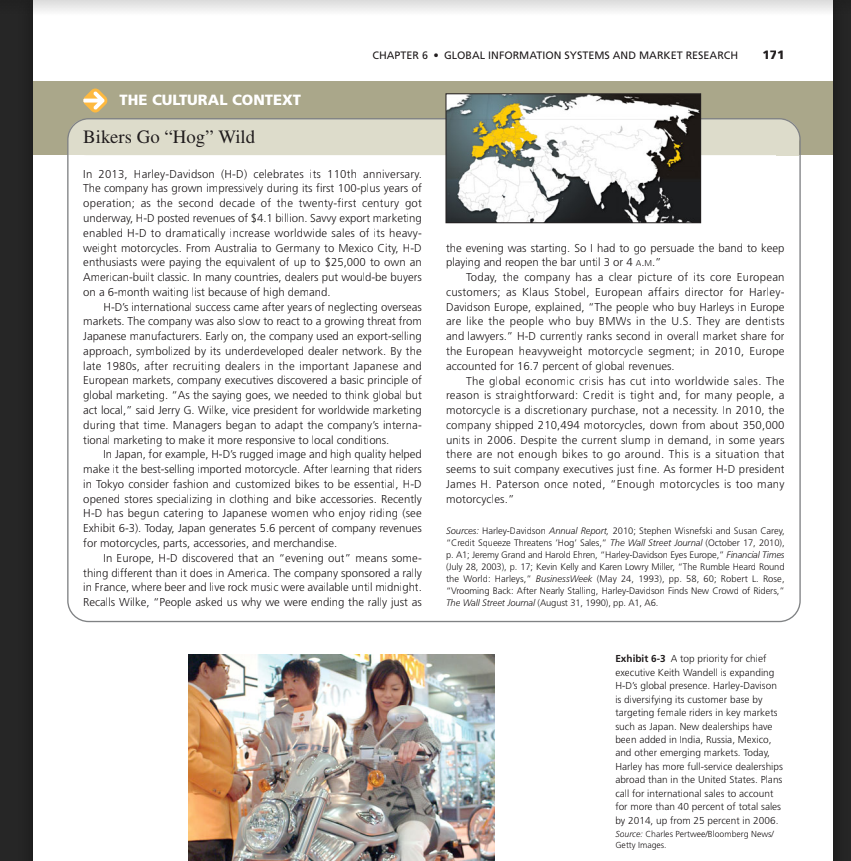Principles Of Marketing
17th Edition
ISBN:9780134492513
Author:Kotler, Philip, Armstrong, Gary (gary M.)
Publisher:Kotler, Philip, Armstrong, Gary (gary M.)
Chapter1: Marketing: Creating Customer Value And Engagement
Section: Chapter Questions
Problem 1.1DQ
Related questions
Question
Which segment would you suggest they target and what strategic advice would you give in targeting this particular segment?

Transcribed Image Text:CHAPTER 6 • GLOBAL INFORMATION SYSTEMS AND MARKET RESEARCH
171
THE CULTURAL CONTEXT
Bikers Go “Hog" Wild
In 2013, Harley-Davidson (H-D) celebrates its 110th anniversary.
The company has grown impressively during its first 100-plus years of
operation; as the second decade of the twenty-first century got
underway, H-D posted revenues of $4.1 billion. Savvy export marketing
enabled H-D to dramatically increase worldwide sales of its heavy-
weight motorcycles. From Australia to Germany to Mexico City, H-D
enthusiasts were paying the equivalent of up to $25,000 to own an
American-built classic. In many countries, dealers put would-be buyers
on a 6-month waiting list because of high demand.
H-D's international success came after years of neglecting overseas
markets. The company was also slow to react to a growing threat from
Japanese manufacturers. Early on, the company used an export-selling
approach, symbolized by its underdeveloped dealer network. By the
late 1980s, after recruiting dealers in the important Japanese and
European markets, company executives discovered a basic principle of
global marketing. "As the saying goes, we needed to think global but
act local," said Jerry G. Wilke, vice president for worldwide marketing
during that time. Managers began to adapt the company's interna-
tional marketing to make it more responsive to local conditions.
In Japan, for example, H-D's rugged image and high quality helped
make it the best-selling imported motorcycle. After learning that riders
in Tokyo consider fashion and customized bikes to be essential, H-D
opened stores specializing in clothing and bike accessories. Recently
H-D has begun catering to Japanese women who enjoy riding (see
Exhibit 6-3). Today, Japan generates 5.6 percent of company revenues
for motorcycles, parts, accessories, and merchandise.
In Europe, H-D discovered that an "evening out" means some-
thing different than it does in America. The company sponsored a rally
in France, where beer and live rock music were available until midnight.
Recalls Wilke, "People asked us why we were ending the rally just as
the evening was starting. So I had to go persuade the band to keep
playing and reopen the bar until 3 or 4 A.M."
Today, the company has a clear picture of its core European
customers; as Klaus Stobel, European affairs director for Harley-
Davidson Europe, explained, "The people who buy Harleys in Europe
are like the people who buy BMWS in the U.S. They are dentists
and lawyers." H-D currently ranks second in overall market share for
the European heavyweight motorcycle segment; in 2010, Europe
accounted for 16.7 percent of global revenues.
The global economic crisis has cut into worldwide sales. The
reason is straightforward: Credit is tight and, for many people, a
motorcycle is a discretionary purchase, not a necessity. In 2010, the
company shipped 210,494 motorcycles, down from about 350,000
units in 2006. Despite the current slump in demand, in some years
there are not enough bikes to go around. This is a situation that
seems to suit company executives just fine. As former H-D president
James H. Paterson once noted, "Enough motorcycles is too many
motorcycles."
Sources: Harley-Davidson Annual Report, 2010; Stephen Wisnefski and Susan Carey,
"Credit Squeeze Threatens 'Hog' Sales," The Wall Street Journal (October 17, 2010),
p. A1; Jeremy Grand and Harold Ehren, "Harley-Davidson Eyes Europe," Financial Times
(July 28, 2003), p. 17; Kevin Kelly and Karen Lowry Miller, "The Rumble Heard Round
the World: Harleys," BusinessWeek (May 24, 1993),. pp. 58, 60; Robert L. Rose,
"Vrooming Back: After Nearly Stalling, Harley-Davidson Finds New Crowd of Riders,"
The Wall Street Joumal (August 31, 1990), pp. A1, A6.
Exhibit 6-3 A top priority for chief
executive Keith Wandell is expanding
H-D's global presence. Harley-Davison
is diversifying its customer base by
targeting female riders in key markets
such as Japan. New dealerships have
been added in India, Russia, Mexico,
and other emerging markets. Today,
Harley has more full-service dealerships
abroad than in the United States. Plans
RO
call for international sales to account
for more than 40 percent of total sales
by 2014, up from 25 percent in 2006.
Source: Charles Pertwee/Bloomberg News/
Getty Images.
Expert Solution
This question has been solved!
Explore an expertly crafted, step-by-step solution for a thorough understanding of key concepts.
Step by step
Solved in 2 steps

Recommended textbooks for you

Principles Of Marketing
Marketing
ISBN:
9780134492513
Author:
Kotler, Philip, Armstrong, Gary (gary M.)
Publisher:
Pearson Higher Education,

Marketing
Marketing
ISBN:
9781259924040
Author:
Roger A. Kerin, Steven W. Hartley
Publisher:
McGraw-Hill Education

Foundations of Business (MindTap Course List)
Marketing
ISBN:
9781337386920
Author:
William M. Pride, Robert J. Hughes, Jack R. Kapoor
Publisher:
Cengage Learning

Principles Of Marketing
Marketing
ISBN:
9780134492513
Author:
Kotler, Philip, Armstrong, Gary (gary M.)
Publisher:
Pearson Higher Education,

Marketing
Marketing
ISBN:
9781259924040
Author:
Roger A. Kerin, Steven W. Hartley
Publisher:
McGraw-Hill Education

Foundations of Business (MindTap Course List)
Marketing
ISBN:
9781337386920
Author:
William M. Pride, Robert J. Hughes, Jack R. Kapoor
Publisher:
Cengage Learning

Marketing: An Introduction (13th Edition)
Marketing
ISBN:
9780134149530
Author:
Gary Armstrong, Philip Kotler
Publisher:
PEARSON


Contemporary Marketing
Marketing
ISBN:
9780357033777
Author:
Louis E. Boone, David L. Kurtz
Publisher:
Cengage Learning